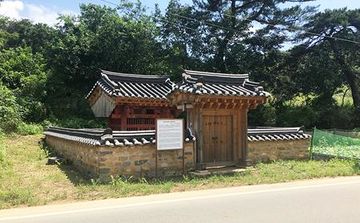"합천 김광부 순절유허비"의 두 판 사이의 차이
(→영문) |
|||
| 33번째 줄: | 33번째 줄: | ||
===영문=== | ===영문=== | ||
'''Stele of Kim Gwang-bu, Hapcheon''' | '''Stele of Kim Gwang-bu, Hapcheon''' | ||
| + | |||
| + | This stele was erected in 1898 to honor Kim Gwang-bu (?-1379), a military official of the Goryeo period (918-1392). | ||
| + | |||
| + | In 1363, Kim was bestowed with a title of the meritorious subject after successfully repulsing the Red Turban army from the capital Gaegyeong (present-day Gaeseong, North Korea) during the Red Turban invasion of 1360**. In 1379, he was relocated to the area of today’s Changwon, where he eventually died fighting against the Japanese pirates who had invaded some areas of Gyeongsang-do Province. The descendants of Kim Gwang-bu erected this stele to commemorate this area in Samga-myeon Township where he fell. | ||
| + | |||
| + | The stele consists of a tortoise-shaped pedestal, body stone, and a rectangular capstone with two engraved dragons holding a wish-fulfilling jewel. | ||
| + | |||
| + | **Do we separate the first and the second red turban invasion if we know which one we’re referring to? Or should it just be “Red Turban invasions of 1359-1362”? | ||
| + | https://en.wikipedia.org/wiki/Red_Turban_invasions_of_Goryeo | ||
===영문 해설 내용=== | ===영문 해설 내용=== | ||
2021년 3월 8일 (월) 14:01 판
| 합천 김광부 순절 유허비 Stele of Kim Gwang-bu, Hapcheon |
|
| 대표명칭 | 합천 김광부 순절 유허비 |
|---|---|
| 영문명칭 | Stele of Kim Gwang-bu, Hapcheon |
| 한자 | 陜川 金光富 殉節 遺墟碑 |
| 주소 | 경상남도 합천군 삼가면 양전리 285 |
| 지정번호 | 경상남도 문화재자료 제666호 |
| 지정일 | 2020년 7월 2일 |
| 시대 | 조선시대 |
| 수량/면적 | 1기(基) |
| 웹사이트 | 합천 김광부 순절유허비, 국가문화유산포털, 문화재청. |
|
|
|
해설문
국문
유허비는 조상의 자취가 있는 곳을 후세에 알리거나 추모하기 위하여 세운 비이다. 김광부 순절유허비는 가수현(嘉樹縣, 현재의 삼가) 지역을 침입한 왜구와 맞서 싸우다가 전사한 김광부(金光富, ?~1379)의 행적을 기리기 위해 1898년 후손들이 전사한 지역에 세운 비석이다.
김광부는 고려의 무신으로 1379년 합포도순문사(合浦都巡問使로 임명되어, 가수현에서 맞서 싸우다가 전사하였다.
김광부의 순절한 내력이 『고려사(高麗史)』, 『고려사절요(高麗史節要)』, 『동사강목(東史綱目)』, 『신증동국여지승람(新增東國輿地勝覽)』 등에 기록되어 있다. 고려 후기의 유학자 목은 이숭인(牧隱 李崇仁)은 오호가(嗚呼歌)를 지어 추모하였다.
왜구 침탈을 막아내다 전사한 기록이 남아있는 김광부 순절유허비는 역사문화유산으로서 가치를 충분히 지니고 있다.
영문
Stele of Kim Gwang-bu, Hapcheon
This stele was erected in 1898 to honor Kim Gwang-bu (?-1379), a military official of the Goryeo period (918-1392).
In 1363, Kim was bestowed with a title of the meritorious subject after successfully repulsing the Red Turban army from the capital Gaegyeong (present-day Gaeseong, North Korea) during the Red Turban invasion of 1360**. In 1379, he was relocated to the area of today’s Changwon, where he eventually died fighting against the Japanese pirates who had invaded some areas of Gyeongsang-do Province. The descendants of Kim Gwang-bu erected this stele to commemorate this area in Samga-myeon Township where he fell.
The stele consists of a tortoise-shaped pedestal, body stone, and a rectangular capstone with two engraved dragons holding a wish-fulfilling jewel.
- Do we separate the first and the second red turban invasion if we know which one we’re referring to? Or should it just be “Red Turban invasions of 1359-1362”?
https://en.wikipedia.org/wiki/Red_Turban_invasions_of_Goryeo
영문 해설 내용
고려시대의 무신 김광부(?-1379)를 기리기 위해 1898년에 세운 비석이다.
김광부는 1361년 홍건적이 고려의 수도인 개경을 침공했을 때, 이를 격퇴한 공으로 1363년 공신이 되었다. 1379년 지금의 창원 지역으로 부임하였으며, 경상도 지역을 침략한 왜구와 맞서 싸우다가 지금의 삼가면 지역에서 전사했고, 그가 전사한 지역을 기념하여 그의 후손들이 이 비석을 세웠다.
비석은 거북 머리가 달린 받침돌, 몸돌, 여의주를 물고 있는 두 마리의 용을 새긴 사각형의 머릿돌로 이루어져 있다.
참고자료
- 지자체 제공 조사자 의견 중 -> 호는 남파(南坡)이고 본관은 의성(義城)이다. 1361년(공민왕 12) 홍건적이 개경을 침공하자 이를 격퇴하여 수복한 공으로 1363년(공민왕 12) 2등공신이 되었다.
- 휴가 길에[05] 뉘라 알랴, 남파김선생순절유허비, eyoone님의 블로그 – 열린 누리, 네이버 블로그 https://blog.naver.com/eyoone/150144636910 -> 2012년 사진. 비석 상세 사진 확인 가능. (블로그 사진에서는 시멘트 담장 안에 많이 쇠락한 모습이나, 지자체 제공 사진을 보면 문화재 지정을 위해 돌담을 다시 세우고 비각도 정비한 것으로 보임.)
